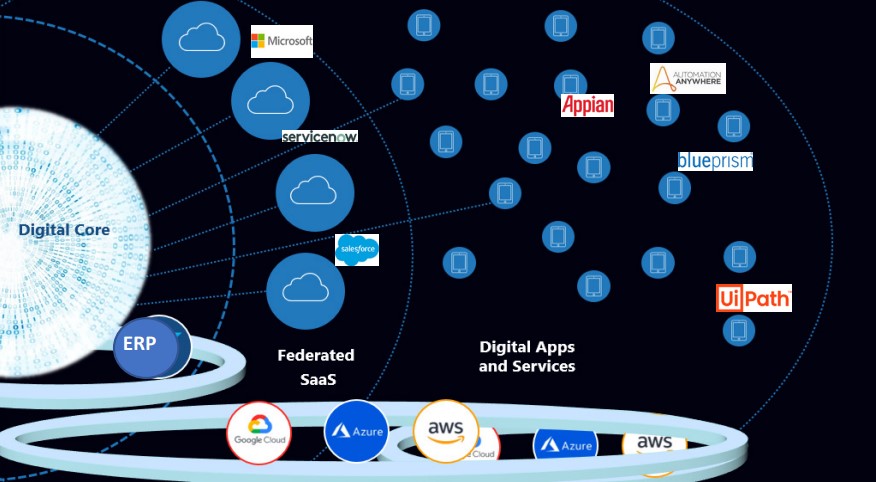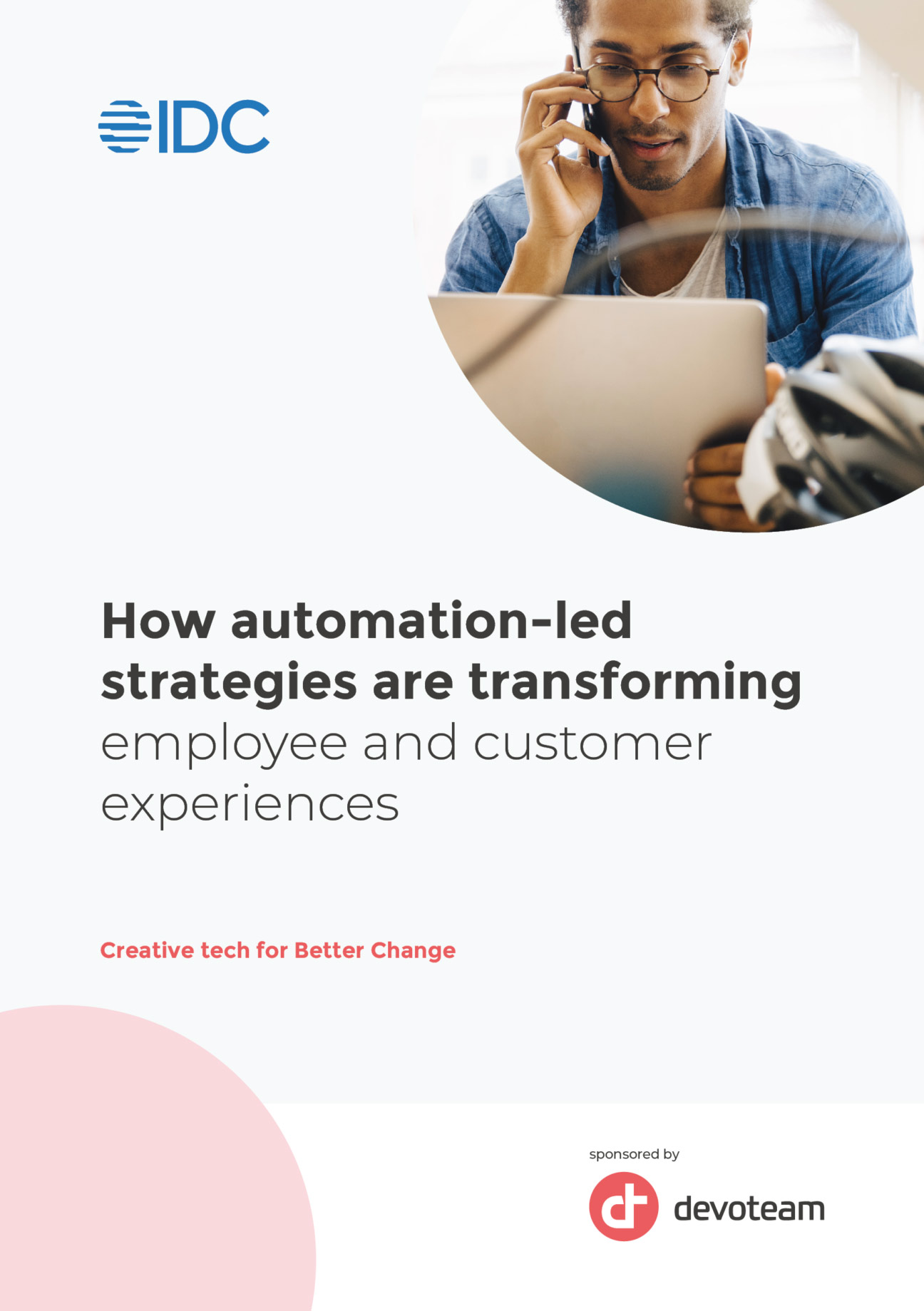Chapter 1: Complexity in the tech landscape leads to multiple routes to enterprise Automation
Platform and service issues to consider for long-term competitive advantage
Business Automation enabled by the cloud and discrete digital apps and services are combining to extend innovation inwards to the core and outwards to the line of business.
Taking back control through best of breed tools
As enterprises take back control of their digital destinies, they are investing in an ecosystem of cloud-based applications and platforms such as Salesforce, Microsoft, Google, and ServiceNow to
run functions and teams in a highly agile way.
SaaS federates automation to the functional teams
These cloud-based platforms connect to the ERP and allow other applications, processes, or technologies to be developed and extended into the business. At IDC we call this a “federated SaaS” model.
These tools are aimed at supporting teams in functions like sales/ customer management, finance, and IT, and can enhance the core ERP backbone through seamless integration and data sharing with the digital core.
Digital apps and services extend automation and experiences outwards into the business
Organizations then need to extend these capabilities and democratize participation across the broader business for maximum benefit. This is where discrete digital apps and services come in.

As they extend out into the business, automation tools like robotic process automation (RPA), and low code application development platforms are being adopted and integrated into the federated SaaS architecture to accelerate business outcomes.
- RPA, for instance, is increasingly being combined with SaaS to provide more contextualized automation in the flow of work.
- Low-code tools are accelerating the development of new automation and workflows such as user-centric mobile apps, employee-facing apps, and workflow and process automation apps that are all aimed at improving productivity, efficiency, and in many cases customer and employee experience.
Use-case 4: Enhancing employee experience and resilience with cloud CRM and Business Automation productivity suite
IDC View: Transforming to a cloud CRM and deploying automated processes supercharged the outcomes for Devotam client as it moved away from outdated and broken sales practices, to deliver a modernized sales process with highly effective results.
IDC spoke with Claire Bouchet, Manager at Devoteam Customer Effectiveness team, to understand the client’s objectives, challenges and solutions using automation.
Enhancing employee experience and resilience with cloud CRM and Business Automation productivity suite Devoteam’s client is a French food services, facilities management, and workplace and technical management services company with over 420,000 employees worldwide. This company serves 100 millions consumers daily across 64 countries.
The Business Challenge
The main objective for Devoteam’s client is revenue growth, and the C-Suite is focused on leveraging technology to drive growth globally and to empower all of its workforce to work towards the same goal. The client identified CRM as the pivotal foundation and engine to drive the growth objective.
The client’s previous CRM was heavy, complex, time-consuming for management, and not user-friendly, and therefore not used effectively by the sales teams. 50% of users logged-in less than once a month; and its prospects and clients data were not recorded. This company needed to transform the CRM with better user experience, mobility and with an engine for collaboration between sales teams and different business units.
The Solution
Devoteam’s client deployed Salesforce in 2019 to provide Sales and Operations Teams with a powerful tool for their day-to-day usage. The new tool was designed to eliminate most important pain points, as well as help them gain productivity with a brand-new experience.
The client wanted to implement the new AS-IS CRM environment in 9 months while engaging strong ambassadors to this huge change as actors to the company growth. With the new CRM – Salesforce Sales Cloud, the client wanted to reinforce alignment between sales, operations and marketing as well as involve its employees in the tool change and solve main issues encountered with the previous system.
Devoteam’s Role
Members from Devoteam Customer Effectiveness team embedded themselves into the client’s team to get an inside view of business processes, operations, hurdles and technology challenges. This helped Devoteam’s experts work closely with the clients’ stakeholders to together determine the right CRM engine, and build a core, standard model across the company’s global operations and build an adoption program.
Devoteam also enabled the customer to translate the company’s go-to-market and business objectives into concrete action. The technology transformation was focused on employee experience and process excellence to encourage active participation and collaboration of sales teams.
Salesforce was deployed in 9 months across nearly 60 countries, for 3,000 users. This included translations into 8 languages. Several applications directly integrated to the CRM allowed the client to improve the user experience and thus operational efficiency.
Devoteam supported the implementation of the new CRM whilst delivering on the client’s key mandates:
- The design of a solution with at least the same functionalities as their current solution
- Delivering the right processes and change management to drive efficiency and effectiveness of the new environment
- Focus on business excellence and common growth goal
- Respect of production deadlines
- Automation/optimization of the business processes managed in their CRM
- Higher utilization of standard Salesforce capabilities
Outcomes
Devoteam client’s new CRM has a 71% correct dataset, which allows it to start from a solid and relevant database.
Sales are growing. The company is now able to identify the right people and influencers for prospects and customers, leading to wins even in complex opportunities.
Redefined skills and roles – so that the client’s sales teams are now empowered and involved in information-driven strategies. This applies to the CRM managers too, whose roles previously were limited to sales assistance. Now the new process and system, they are all moving to a Center of Excellence team for customer championship.
Key Learnings
Transform the user experience. This is an outstanding outcome of the project. It has provided sales users with paths and recommendations through a gaming experience while identifying the pain points.
Exploit data-led insights. The client is now able to track performance indicators to drive adoption and a community of ambassadors to further promote the continuous use of the new
CRM.
Next Steps
Devoteam client uses now the CRM to cover the client life cycle; from market intelligence to targeting, from opportunity creation to solution & contract Design , from solution mobilization, to Contract Management and Client retention.
To reinforce the management of the whole Client Lifecycle & get robust client 360° view, Devoteam is now working on 3 main topics :
- Adoption: full adoption program with defines KPIs that translate strategic objectives into business actions
- Marketing and Sales alignment: lead generation and scoring
- Sales and financial team alignment: High value in integrating finance views to sales operations.

Chapter 2: Framing Business Automation Excellence: Understanding the Three Pillars for Optimum Success
Business automation at scale is hard. In charting the way forwards, organizations must think carefully about the people, technology, and process design changes that need to be made.
Moving from proofs of concept (PoC) to scaling solutions is disruptive. Automation solutions start to test stable paradigms and established cultural values. Solid game plans need to be in place that can tie the end-to-end program together from a strategic design, creation, integration, and change standpoint. This will require sound advice and in many cases resource input on the best approaches and the vision, and understanding the opportunities, addressing the selection criteria and deployment options, as well getting access to the right resources (dev talent, automation, security, etc.) and the ability to distribute innovations and encourage adoption.
The ultimate state of business automation excellence is one that supports successful organizational transition to an automation CoE capable of managing, governing, and even building new automation innovation, so that they are available and reusable across the business. This is a complex task, since it needs to be led by the business but with key stakeholder engagement from IT to help ensure governance and controls. Success will often be measured on adoption and usage by business teams as well as against key business outcome KPIs.

Use-case 5: Low code provides a rapid digital solution automating time-consuming manual tasks productivity suite
IDC View: Automation is central to PSA Sines’ expansion plans at its port in Sines, Portugal, which expects to double in size in the next two years. Automated systems and processes are seen as the solution to challenges around operating efficiency and competitiveness and availability and access to skills.
IDC spoke with Robson Moreira, PSA Sines’ Head of IT, to understand the ambitions and opportunities of using automation.
The faster we get a vessel in and out of the port, the more business we get. So, automation is essential for our long-term efficiency and competitiveness. Today, we are more precise, sharp, accurate, and competitive.
Sines is the largest artificial port in Portugal. PSA Sines manages the container shipments terminal, which accounts for over half of Portugal’s container cargo.
The Business Challenge
PSA Sines was running a heavily manual process to manage the scheduling of port machinery and personnel on the yard. A complex environment with up to 250 staff per shift deployed on trucks, cranes, and vessels, PSA Sines was reliant on manually filling out and checking spreadsheets to assign personnel to tasks, which took hours daily and did not make the best use of people’s skills or willingness to learn new ones and was not adaptable to dynamic needs such as personnel on vacations. Attracting and retaining talent was therefore another challenge faced by PSA Sines in both IT and operations. This has the potential to be a barrier to expansion plans in which it aims to double in size over the next few years.
The Solution
PSA Sines embarked on an innovation project called auto deployment system (ADS) in 2019, to automate the manual assigning of port tasks. Robson Moreira selected OutSystems as the low-code application development platform on which to build the new system. A prototype was built very quickly to “sell to the business.” It was then easy to move to the full production version, which can connect with PSA Sines’s SAP back-end system to capture shift information and skills, as well as systems for managing the infrastructure.
Devoteams Role
As an OutSystems partner, Devoteam provided the development teams to build the product and provide ongoing support. Its role was very much as an extension to PSA Sines’s internal teams. Working with the
company’s HQ in Singapore and HR and engineering teams, it was able to develop the rules engine and the middleware on OutSystems to integrate data from different systems to automate the various scheduling and task assignment activities. The user interface created is highly visual and user friendly, with drag and drop functionality for the non-technical user to simply adjust schedules if required. It also integrates with visual displays that operations teams can see as they report for work, which provides them with immediate information on their assigned tasks and any alerts for the day.
Outcomes
User-led feedback driving improvements — Version 1 of the ADS was rolled out in just four months, allowing PSA Sines a fast response to the problem at hand. Numerous iterations have since been built on the initial platform to improve the system based on user feedback.
Improved employee satisfaction — Since tasks are now assigned automatically by the system, there is a level playing field for all employees on job allocations. The previous manual approach was not considered transparent.
Significant time saved through automation — ADS combines equipment demand data from different systems at its wharf and yard operations to match staff with the appropriate skillset automatically. This has removed the need for time-consuming manual referencing and task
Skills rotation — ADS allows PSA Sines to rotate its personnel across various skillsets in an equitable manner to maintain skill relevance.
Key Learnings
Better to have a partner to do this. Even though PSA Sines has an internal IT department, Moreira needed a team of experts in their chosen OutSystems solution. This was essential during the development and also in helping it identify the latest versions of the software and negotiate and implement upgrades on its behalf. “There is a cost of course, but a safety too, to know they’re there.”
Next Steps
PSA Sines is working on another phase of the ADS project. After continuously iterating on Phase 1, Phase 2 of the project was started in 2021. When combined with Automatic Equipment login & GPS tracing, the system will enable supervisors to track exactly where vehicles are in the yard and make changes during shifts. This is being developed by in-house IT and data teams. It will involve the use of data and link up with other PSA Sines proprietary systems to preempt workload and resource demand up to three days ahead and better match demand with supply of resources.
